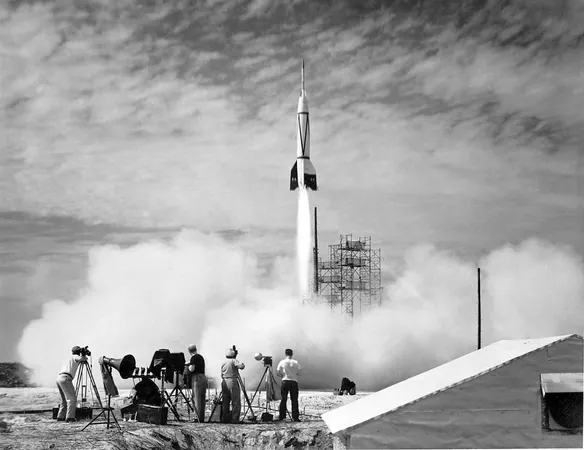
Megaroc: The British Space Program That Wasn’t – Was History About to Change?
2025-04-03
Author: Siti
Seizing the V-2 Rocket Technology
The "V" in V-2 stands for "Vergeltungswaffen," meaning "vengeance weapon." It was a more sophisticated successor to the V-1 flying bomb. The Nazi regime, employing forced labor, produced over 5,000 V-2 rockets during the war, deploying them devastatingly against targets in Europe.
In early 1945, American forces reached the German V-2 construction site at Mittlewerk before the Red Army, capturing a wealth of rocket technology. This haul included enough parts to build around 100 V-2 rockets, which were transported to New Mexico for in-depth analysis and utilization in early U.S. rocket program development, aided by a number of captured German scientists, most notably Wernher von Braun.
On the other hand, the British managed to acquire only a small cache of parts—sufficient for a handful of V-2 rockets. Nonetheless, by late 1945, they had successfully test-fired three V-2 rockets under Operation Backfire, marking the beginning of their own exploration into rocketry.
Transforming Missiles into Spacecraft
British researchers quickly recognized the potential of the V-2 beyond its destructive capabilities. Though it lacked the thrust to place a payload into orbit, it could achieve suborbital flight sufficient for human spaceflight under a carefully planned mission.
In 1946, H.E. Ross of the British Interplanetary Society proposed modifying the V-2 into what became known as Megaroc, short for "mega-rocket." This advanced design included structural reinforcements and was optimized to carry a small capsule with a human occupant, reaching an altitude of 186 miles (300 kilometers)—an extraordinary aspiration for its time.
Megaroc would have replaced the traditional warhead with a capsule designed for one crew member, equipped with communication tools and scientific instruments. The capsule was crafted to stabilize itself with thrusters, offering the occupant breathtaking views of Earth. Both the rocket's booster and the capsule were meant to descend via parachutes—a futuristic design feature that omitted a heat shield, as the parachute was to be deployed at high altitude.
Dreams Dashed by Economic Reality
Despite the visionary concept, Megaroc was doomed before it ever lifted off. The aftermath of the war left Britain financially strained, and the urgency of developing atomic bomb capabilities diverted attention and funding away from space exploration. With resources allocated to long-range bomber projects, the dream of launching a human into space faded.
Yet, reflecting on Megaroc’s ambitious proposal highlights how groundbreaking the idea was for its time. Had the British government committed to this endeavor, it’s conceivable that the first human spaceflight could have predated Yuri Gagarin's historic mission in April 1961 by a decade, significantly altering the narrative of space exploration.
While Megaroc stands as a symbol of what could have been—a tantalizing glimpse into an alternative historical timeline where the pioneering human in space could have emerged from Britain—it serves also as a reminder of the frailty and unpredictability of technological advancement and geopolitical priorities.
Could this ambitious project have rewritten history? The answer may lie in the stars, forever intrigued by the path not taken.




 Brasil (PT)
Brasil (PT)
 Canada (EN)
Canada (EN)
 Chile (ES)
Chile (ES)
 Česko (CS)
Česko (CS)
 대한민국 (KO)
대한민국 (KO)
 España (ES)
España (ES)
 France (FR)
France (FR)
 Hong Kong (EN)
Hong Kong (EN)
 Italia (IT)
Italia (IT)
 日本 (JA)
日本 (JA)
 Magyarország (HU)
Magyarország (HU)
 Norge (NO)
Norge (NO)
 Polska (PL)
Polska (PL)
 Schweiz (DE)
Schweiz (DE)
 Singapore (EN)
Singapore (EN)
 Sverige (SV)
Sverige (SV)
 Suomi (FI)
Suomi (FI)
 Türkiye (TR)
Türkiye (TR)
 الإمارات العربية المتحدة (AR)
الإمارات العربية المتحدة (AR)